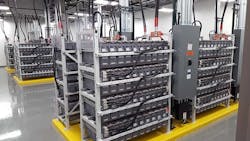PHOENIX, Ariz. – A new standard being developed by the National Fire Protection Association could have a big impact on the use of batteries in UPS systems, according to a group of data center energy experts, who are seeking to mobilize the industry to seek revisions.
The new NFPA 855 standard was developed to provide safety guidance for the growing use of lithium-ion batteries in uninterruptible power supply systems (UPS) that provide emergency power in data centers and other mission- critical facilities.
NFPA 855 includes new design and testing protocols for lithium-ion UPS systems. But data center professionals say the standard has been broadened in ways that could alter current practices in deploying other types of data center UPS systems, and could potentially be applied to existing facilities.
“It’s a work in progress, but it’s impact would be profound,” said Ed Rafter, a Senior Associate at GBA (George Butler Associates), and former executive at The Uptime Institute. “The problem is that most folks in the data center industry are unfamiliar with NFPA 855.”
A group of concerned data center executives sent out a bulletin last week urging the industry to provide feedback on NFPA 855, which is open for comments through April 29. If adopted in its current form, the new standard “has the potential to disrupt all data center construction in all jurisdictions that have adopted NFPA standards,” the bulletin warned. “As written this standard can be applied retroactively to existing battery installations.”
Why NFPA Standards Matter
The NFPA is a non-profit group that develops codes and standards for the fire marshals and inspectors who enforce fire codes in cities and towns across the country. Its recommendations govern the work of AHJs (Authorities Having Jurisdiction) who inspect construction of data centers and other buildings.
NFPA 855 (Standard for the Installation of Stationary Energy Storage) would impact all battery installations providing more than 70 kilowatts (kW) of power, which includes nearly all data centers, which typically install emergency power systems to protect many megawatts of IT capacity. Sections of the new standard are already being implemented in Los Angeles, New York and other cities.
The data center UPS market has historically been dominated by valve-regulated lead acid batteries (VRLA). In recent years the industry has begun adopting lithium-ion batteries, which are commonplace in mobile devices like smartphones and laptop computers.
UPS systems using lithium-ion batteries offer multiple advantages over lead-acid batteries, including a longer lifetime, reduced weight and footprint, and less rigid cooling requirements.
But lithium-ion batteries also come with fire risks, as seen in incidences of smartphones catching fire. When improperly managed or stored, a lithium-ion battery can reach a “thermal runaway” state more easily than other types of batteries. A primary benefit of lithium-ion – its ability to store large amounts of energy – can become problematic in suppressing a fire. Advocates of lithium-ion UPS systems say these concerns can be safely managed with monitoring.
New Battery Tech, New Rules
Lithium-ion batteries are one of several new types of energy storage systems the NFPA is integrating into its fire safety standards, including storage systems to support photovoltaic solar panels and electric vehicles.
The changes in NFPA 855 prompted a response from members of the IEEE Power and Energy Society’s Energy Storage and Stationary Battery Committee (ESSB), who circulated an informational bulletin to data center professionals to raise awareness of the issues it may create for data centers.
“The effort to standardize and codify installations of Li-Ion batteries as well as other new technologies is praiseworthy,” members of the IEE ESSB wrote. “However, the 855 committee has lumped in lead acid and Ni-Cd batteries. These batteries have a very long track record of safety across multiple industries. The impact of this overreach has the potential to stall construction and retroactively require redesign of existing data centers.”
As an example, one section could require more batteries to be housed inside cabinets. Section 4.2.1 of NFPA 855 “requires all lead acid battery, vented (VLA) or sealed (VRLA) to be UL listed unless they are in cabinets and listed under UL 1778. This especially impacts data centers that use an open battery rack configuration,” the bulletin reports, adding that it is “is not aware of any UL listed lead acid batteries for stationary applications.”
“You would be required to disperse the batteries so they take up a larger amount of space,” said Rafter.
Data center power experts are encouraging manufacturers, engineers, builders and end users to review and understand the impact of the draft standard, as well as urging NFPA members to attend the NFPA Conference & Expo June 17-21, 2019 in San Antonio and vote to return the draft standard to committee for revision. NFPA members have until April 29, 2019 to file a Notice of Intent To Make A Motion (NITMAM) on this standard.
The upcoming BattCon conference in April will feature a panel on NFPA 855 led by Bill Cantor, a Vice President for TPI and long-time member of IEEE ESSB.
Data Center Frontier contacted the NFPA for a response to the concerns raised by the data center groups, but we have not yet had a response.
Testing at Issue for Lithium-Ion Deployments
The focus on lithium-ion batteries comes as these systems are beginning to gain traction in the market. “2018 was a turning point,” said Jeff Kessen, Vice President for Global Energy Storage at Vertiv, a leading vendor of UPS systems. “The number of data centers buying lithium-ion grew markedly last year, The adoption rate exceeded 25 percent of our new UPS sales by the end of last year. The rate of growth is significant, and I expect that to continue this year.”
The NFPA 855 standard calls for “large-scale fire testing” of batteries to ensure that fires will not spread, citing a testing methodology from UL (Underwriters Laboratory) which offers certification and safety testing for industrial products. The UL 9540A protocol specifically tests lithium-ion batteries for thermal runaway conditions, but industry say the guidance may not be thorough enough.
“Battery manufacturers will need to run the large scale fire tests soon, as there’s going to be increasing appetite for the data,” said Kessen. “A central issue is that there’s a specification of a fire test, but UL has not specified pass/fail targets. So there’s some ambiguity in the market.” Kessen said that leaves more interpretation of test results up to local AHJs.
“I suspect we’re going to have a protracted period where AHJs are going to need to know more about lithium-ion batteries,” said Kessen. “I think the risk to the industry is that different AHJs might look at the same data and reach different conclusions. For the short term, since the AHJ has all the responsibility and authority, anyone who wants to site (lithium-ion systems) in a facility should engage the local authority early in the process.”
The NFPA 855 standard calls for lithium-ion batteries to be used in groupings no larger than 250 kW, with each grouping separated from others by at least three feet. That creates a design consideration for power rooms.
“The implication for the industry is that if you do have to spread your lithium-ion cabinets three feet apart, it impacts the space available,” said Kessen. “I don’t think it changes the economics, as lithium-ion is justified based on its longer life.”
Seeking Context on Existing UPS Systems
A concern for some data center professionals is the potential that NFPA 855 measures designed to assess and manage lithium-ion systems could be applied to existing systems.
“We’re working with IEEE to put this into context,” said Rafter. “It started out as a response to lithium ion batteries, because of the incidents with lithium-ion batteries. There are very real concerns. It started out as an LI-specific document and grew into encompassing every battery technology. Some of those technologies have been in existence for a number of years.”
“You currently don’t have anything grandfathered in,” said Dan Lambert, Senior Product Manger at ZincFive, and also a member of the IEEE ESSB committee. “It’s not a single pain point. It’s going to have impacts on hospitals as well as data centers.”
For the data center industry, awareness is an important first step in crafting a response to the NFPA recommendations. Right now, awareness remains low, according to Lambert, who sampled his audience during a session on battery technology at last week’s Data Center World event.
“I asked how many people were aware of NFPA 855,” said Lambert. “There were 84 people in the room and only six raised their hand.”






